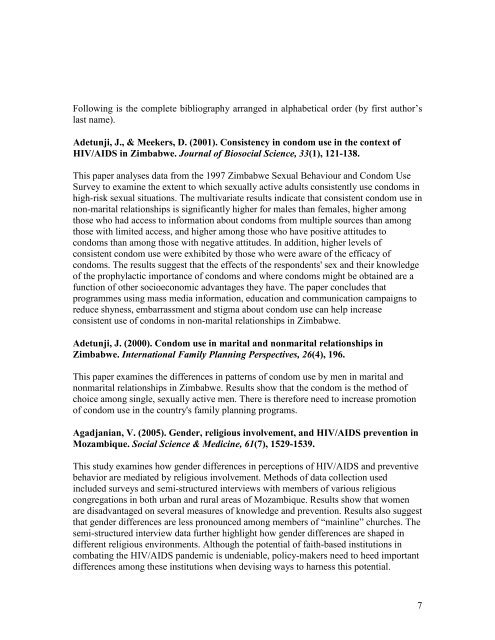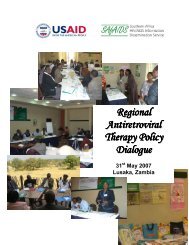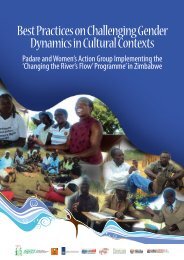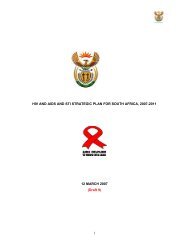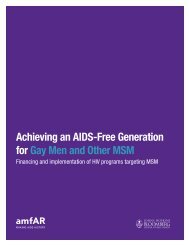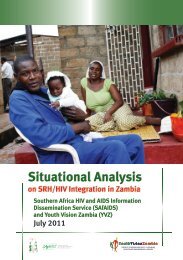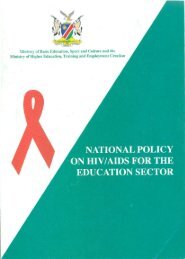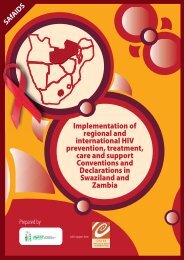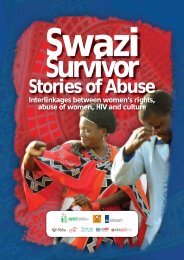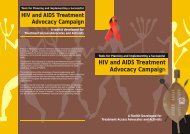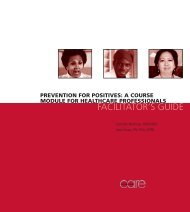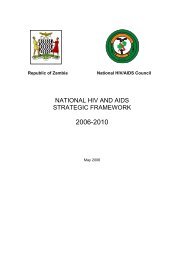Annotated Bibliography-Challenging Gender Dynamics ... - SAfAIDS
Annotated Bibliography-Challenging Gender Dynamics ... - SAfAIDS
Annotated Bibliography-Challenging Gender Dynamics ... - SAfAIDS
You also want an ePaper? Increase the reach of your titles
YUMPU automatically turns print PDFs into web optimized ePapers that Google loves.
Following is the complete bibliography arranged in alphabetical order (by first author’slast name).Adetunji, J., & Meekers, D. (2001). Consistency in condom use in the context ofHIV/AIDS in Zimbabwe. Journal of Biosocial Science, 33(1), 121-138.This paper analyses data from the 1997 Zimbabwe Sexual Behaviour and Condom UseSurvey to examine the extent to which sexually active adults consistently use condoms inhigh-risk sexual situations. The multivariate results indicate that consistent condom use innon-marital relationships is significantly higher for males than females, higher amongthose who had access to information about condoms from multiple sources than amongthose with limited access, and higher among those who have positive attitudes tocondoms than among those with negative attitudes. In addition, higher levels ofconsistent condom use were exhibited by those who were aware of the efficacy ofcondoms. The results suggest that the effects of the respondents' sex and their knowledgeof the prophylactic importance of condoms and where condoms might be obtained are afunction of other socioeconomic advantages they have. The paper concludes thatprogrammes using mass media information, education and communication campaigns toreduce shyness, embarrassment and stigma about condom use can help increaseconsistent use of condoms in non-marital relationships in Zimbabwe.Adetunji, J. (2000). Condom use in marital and nonmarital relationships inZimbabwe. International Family Planning Perspectives, 26(4), 196.This paper examines the differences in patterns of condom use by men in marital andnonmarital relationships in Zimbabwe. Results show that the condom is the method ofchoice among single, sexually active men. There is therefore need to increase promotionof condom use in the country's family planning programs.Agadjanian, V. (2005). <strong>Gender</strong>, religious involvement, and HIV/AIDS prevention inMozambique. Social Science & Medicine, 61(7), 1529-1539.This study examines how gender differences in perceptions of HIV/AIDS and preventivebehavior are mediated by religious involvement. Methods of data collection usedincluded surveys and semi-structured interviews with members of various religiouscongregations in both urban and rural areas of Mozambique. Results show that womenare disadvantaged on several measures of knowledge and prevention. Results also suggestthat gender differences are less pronounced among members of “mainline” churches. Thesemi-structured interview data further highlight how gender differences are shaped indifferent religious environments. Although the potential of faith-based institutions incombating the HIV/AIDS pandemic is undeniable, policy-makers need to heed importantdifferences among these institutions when devising ways to harness this potential.7


